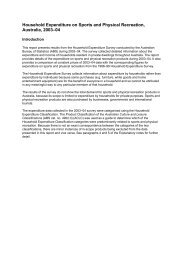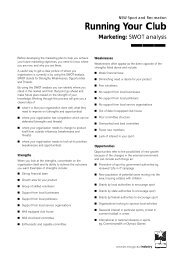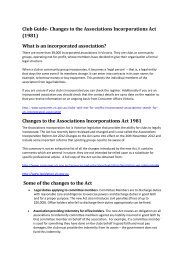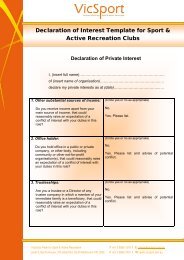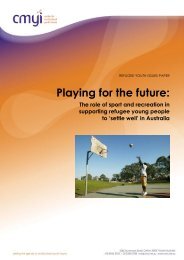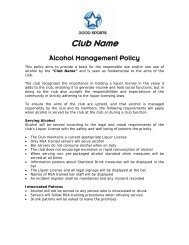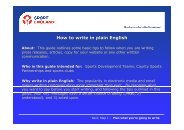School Playing Fields: Planning and Design Guidance - VicSport
School Playing Fields: Planning and Design Guidance - VicSport
School Playing Fields: Planning and Design Guidance - VicSport
Create successful ePaper yourself
Turn your PDF publications into a flip-book with our unique Google optimized e-Paper software.
1: <strong>Planning</strong> the siteSecondary <strong>School</strong>sRange of pitches neededThe pitches which a school site might need toaccommodate will depend on curricular <strong>and</strong>extra-curricular programmes <strong>and</strong> communitydem<strong>and</strong> but could include the following.Potential winter sports pitch requirementsFootballHockeyRugbyHard surface areas <strong>and</strong> multi-courts might also be expectedto accommodate:Small sided footballSmall sided hockeyNetballPotential summer sports pitch requirementsAthleticsCricketHockey †RoundersShinty*SoftballHard surface areas <strong>and</strong> multi-courts might also be expectedto accommodate:BasketballTennis†Although traditionally considered a winter sport, hockey isnow played all year round.*Shinty is now played over the summer with a winter closedseason.The suggested ideal for secondary school sitesis one or more SGPs supported by natural grassplaying fields. This arrangement should enablethe higher capacity of a synthetic surface to becombined with the flexibility of a large area ofnatural grass playing fields. These should beaugmented by multi-use games areas (MUGAs)<strong>and</strong> hard surface areas which may be used forboth curricular purposes <strong>and</strong> as kickaboutsduring break times but which should not beconsidered as teaching spaces for the purposesof the calculations.Managing restricted spaceIf a school site is short on space, a higher levelof synthetic <strong>and</strong> hard surface area provision maybe required, as may an increase in the numberof indoor facilities. This option should not simplybe used as a means of reducing the spacerequirements of a school: if a large enough site isavailable then it should be used. Extra-curricularprogrammes are organised in tight time b<strong>and</strong>simmediately after school. Any reduction in thelevel of facilities provided in a school may restrictthe number of activities, levels of use <strong>and</strong>numbers taking part.Using off-site facilitiesEven with enhanced all-weather <strong>and</strong> indoorfacilities, in some very constrained sites it maystill be impossible to make adequate provision<strong>and</strong> alternatives may have to be sought, such asuse of dedicated off-site facilities <strong>and</strong> shared useof facilities. However, using off-school sites canreduce the time allocated to physical education(as more time is spent travelling) <strong>and</strong>, if the hireof transport is necessary, can have revenue costimplications which might be difficult for someschools to meet. Using off-site facilities shouldonly be considered as a last resort although theycan make a useful contribution by accommodatingweekend matches by school teams.Recommended size of sports pitchesThere are several sources of published advice giving recommended sizes for school/youth sportspitches (from national governing bodies of sport <strong>and</strong> from previous Sports Council <strong>and</strong> Governmentdesign advice). Based on this advice <strong>and</strong> on recent consultations with the relevant bodies, sportscotl<strong>and</strong>recommends that planning for school playing fields should be based around the pitch sizes detailedin the table below.Figure 10: Optimum secondary school pitch sizes.Pitch Optimum Pitch Minimum run-off With run-off Total area (m 2 )age group dimensions (m) areas (m) areas <strong>and</strong> lateral(l:w)strip † (m)SGP (Multi-Purpose) All 100 x 60 3:3 106 x 66 6,996SGP (Hockey) All 91.4 x 55 5:3 101.4 x 61 6,185Football Size 1 S4-6 100 x 60 6:4.5 112 x 78 8,736Football Size 2 S1-3 90 x 45 6:4.5 102 x 63 6,426Rugby Size 1 S4-6 113* x 60 3:4.5 119* x 78 9,282Rugby Size 2 S1-3 97* x 50 3:4.5 103* x 68 7,004Shinty All 140 x 70 6:4.5 152 x 88 13,376*Includes 9m goal areas for size 1 <strong>and</strong> 6m goal areas for size 2.†A 9m strip to allow lateral movement of pitch to reduce wear. Not required for SGPs.Shinty, cricket <strong>and</strong> athletics are discussed below.Number of pitches needed at schoolsHere are the key points to consider whenassessing the number of pitches required ata school:• Use the example outlined in Section Two of thisdocument to help calculate how many sportsfields are required per school.• The choice of what pitches to provide shouldbe based on the curricular <strong>and</strong> otherrequirements of the school but should beselected from the pitch types <strong>and</strong> guidelinesizes in Figure 10.• If only one football or rugby pitch is required,a Size 1 pitch should be provided. Althoughsome schools may focus on particular sports<strong>and</strong> this is reflected in the choice of pitches, arange of pitch sports should be catered for asthe curriculum can change over time (as canthe nature of after school activity).Applying the above principles, an average rangeof curricular <strong>and</strong> extra-curricular pitch sportswould suggest the following pitch provision.<strong>School</strong> <strong>Playing</strong> <strong>Fields</strong> 30<strong>School</strong> <strong>Playing</strong> <strong>Fields</strong> 31



